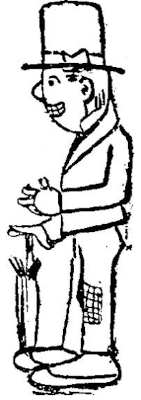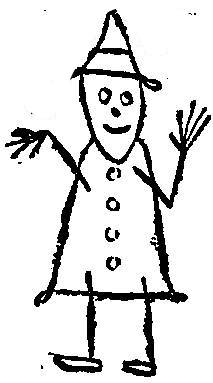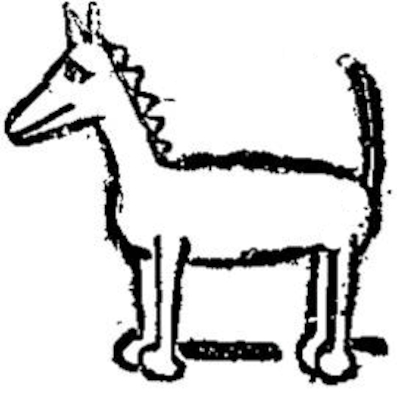This article has been transcribed from a copy of the Cardiff Times in the online collection of scanned Welsh newspapers 1804-1919 in the National Library of Wales, with grateful recognition of the free access accorded to all readers. Paragraph breaks have been introduced for easier reading.
This is a simple exercise in nonsense, in which Samuel alternately takes his children's artworks seriously and makes fun of them. There are gestures towards, rather than references to art movements and genres, not to mention the great critic and writer, John Ruskin. Few of the mentions would stand up to much scrutiny, but the children and their works are very recognisable. Samuel is of course gently satirising the genre of periodical art criticism. The technique of introducing a word belonging to a very different mode of discourse, such as 'beef extract', is a staple of this style of article. —— David Skilton

'This is a man,' drawn by a very 'Early English' artist of six. Supposed to represent myself. Observe the smile.
AN article on Art is rather a large order, isn't it, dear sir; takes in a lot of ground, as the statesman said when he annexed a territory. But let me explain that the particular art to which I refer is that of drawing. My intimate friend Ruskin, a gentleman who writes a bit on art occasionally, says that all men can learn to draw still objects – if he refers to whiskey 'still' objects I cordially agree with him. If a man can’t draw anything he can at least draw corks, or ale, or that form of tricyclic called by vulgar people, a wheelbarrow. Most people with a taste for drawing begin very early, I have noticed. Chalk drawings, of the murally decorative order are about the mark. The shutters of an unlet shop afford the young artist admirable space for the exercise of his skill. In default of any blank space, even the back of a friend will suffice, and should chalk be scarce, it is little short of marvellous what breadth of effect, delicacy of colouring, and mastery of handling can be got out of pottery-mould, judiciously mingled, in order to get in judicious shadows, with the end of a partially burnt stick. I have even known a boy with a piece of charcoal so far utilise his opportunities and instincts as to draw out a bold design upon a bed sheet hung up to dry, and very striking was the effect — when the lady who had been washing the sheet caught him up. The lady came suddenly — soap suddenly in fact, and she lathered him in more senses than one. A slate is an admirable vehicle for conveying the young artist's impressions, and when the kind, good schoolmaster has gazed in a furtively admiring sort of way upon the result[,] I have known him to make a very forcible impression upon the youthful liner.

Another 'impressionist' portrait. Samuel, from a nephew's point of view, intended for presentation to the Art Gallery.
It is a notable fact that the taste of the juvenile artist always leans in the first instance towards the realm of caricature. Not content with the mere representation of men and women and animals as they are, the young aspirant to artistic fame always gives free rein to his fancy and produces the most charming results — except in the view of the person delineated. Furthermore, lest there should be any vague and distressing doubts as to the originals depicted, the tyro proceeds to supply letterpress to the 'cuts,' so to speak, and very larconically writes beneath his works of art, 'This is higgins the old hass,' or 'tommy topham SNEAK,' or, 'who stoal the donkey,' or some other cheerful comment.

'This is gal'; drawn by another of them.
In the way of landscape and seascape art, there are many juvenile peculiarities. One of these is that any house which may be represented shall have such an amount of smoke issuing from its chimneys as would justify any smoke inspector of well-regulated mind to take proceedings at once. The same sooty tendency pervades graphic illustrations of steamboats and railway engines, which latter are a very favourite subject and invariably very groggy and distorted about the wheels. The houses have a habit of having a roof a bit too heavy for them, and to develop a perfect eruption of chimneys and windows. Sometimes the sense of humour to which I have referred makes itself strongly felt in this matter, and one of the numerous windows is made the means of showing an innocent child (with a very large head) falling out of a second-floor window. Possibly the very large head makes it over-balance in this way. In regard to vessels sailing on a very flat sea (and all the fishes plainly to be seen swimming beneath), it may be said at once that their crews are in gross disproportion to the size of the vessels themselves, and this, I must say, is the fault of the artist himself. The look-out man, for instance, is considerably taller and bulkier than the mainmast of the vessel (a four-masted barque), which would doubtless give him a great advantage in looking out ahead. Then again there is too great a display of rudder to accord weIl with modern notions of naval architecture. In landscape the creation holds a conspicuous position. It is at times uncertain what the nature of the 'baste' [beast] may be, and were Noah here again with his ark he might find some difficulty in identifying the specimen – might have 'em in hi[s] inventory, so to speak. Anyhow, they are easy to spot (so to say) as quadrupedal; indeed, they not seldom seem to burst over with legs and tail, and there is something contemplative in their fixed gaze, which is essentially fetching to the studious mind.

Undoubtedly an animal, species uncertain; probably one of the sort that they make beef extract out of.
Amongst mixed figure subjects – where more than one figure is represented – battles are the common idea, and I am bound to say that the innate patriotism of the British boy is always in evidence, for the English troops of his picture are invariably victorious, which is no more inaccurate in fact tha[n] the method of all eminent French battle painters, who invariably represent the gallic warrior as coming off the best — even at Waterloo. A good many of the warriors are playing the part of the 'dead on the field,' and it is no matter for wonder that they are very dead indeed, for have they not bayonets and swords and daggers stuck all over them and pointing with the hilts to the heavens[?] And naturally there is a gun bursting in the foreground, whilst mingled with its wreck are a few miscellaneous hands and legs and arms and heads, all blown skies high.
Last modified 29 March 2022